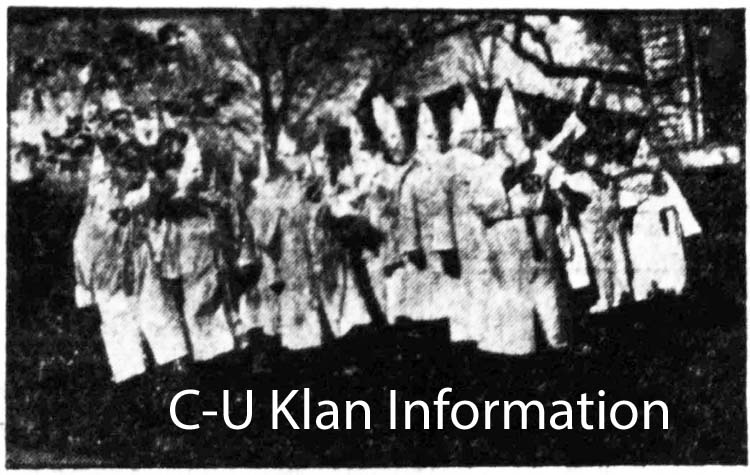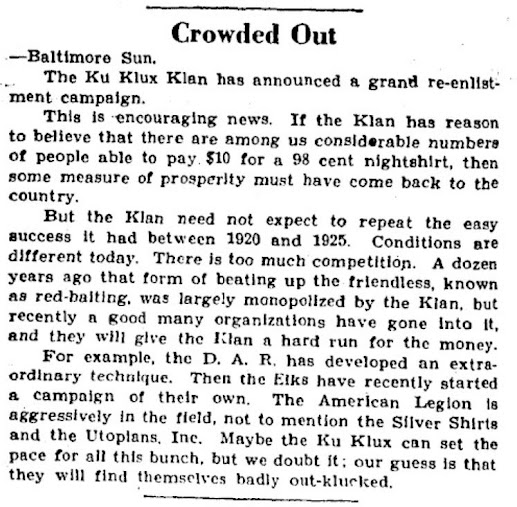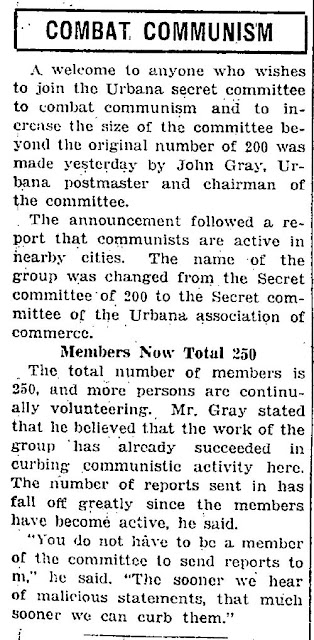Her Klan wedding album is available in the Champaign County Historical Archives at the Urbana Free Library, with mundane and typical notes, stories, and firsts... as well as descriptions of giant electric K's and Klan riddled clippings:
Over the course of 1928, the national organization would be renamed and end the year losing key Supreme Court battles that threatened its continued existence. It would, however, claim victory in the form of the Immigration Act of 1924 and its related extreme restrictions. From the the 2/23/1928 Courier Editorial on the name change and the 11/20/1928 News-Gazette with an overview of the Court cases:
While the local Klan organization itself dropped out of the headlines and the national organization struggled on legal and membership dues, the local Klansmen themselves didn't disappear. There were no public disavowals or repercussions. The local 1928 specimen ballot lists numerous Klansmen who went on to hold onto or win many local offices printed in the 11/3/1928 Courier (click to enlarge):

The work of verifying various Klan members, ruling out people with the same or similar names, potential typos, alternate spellings, and other potential identification errors is tedious. But even so, we find many confirmed members such as Boyd S. Blaine, Champaign County Circuit Clerk and Klan member #2227; Roy R. Cline, Champaign County State's Attorney and Klan member #180; Godfrey Sperling, Champaign County Supervisor and Klan member #968, John Bruder, Champaign County Sheriff and Klan member #112; as well as a few other likely and possible members just on this ballot and other ballots around this time.
Regardless of the continued existence of the Klan and the continued power of both public and known Klan members in positions of local government and law enforcement, the Urbana Courier declared the organization a thing of the past this same year of 1928. It notes the recent Supreme Court case losses and still defends the "desperate need" filled by the original Klan. From the 11/20/1928 editorial:
Once again the Republican paper deems many of its aims and aspirations "praiseworthy" and "patriotic" while minimizing the impact it had on those it targeted. The reality of fear, intimidation, and increased enforcement of the "color line" in segregated Champaign-Urbana and Champaign County stands in stark contrast with the editorial's description. The Klan rose here in the aftermath of the Red Summer and during other pogroms and racial violence throughout Illinois.
This was also during a period of time known as the "Great Migration" where massive numbers of Black people were fleeing the South to Northern towns and cities looking for places to live and opportunity abundant throughout Illinois and growing Champaign County. But as Champaign County grew, Black people were more segregated and pushed out of more areas, even as migration to the area was increasing and space in segregated Chicago had become a crisis. Here's a chart of local census data in and around this period of. It shows how the Black population grew in Champaign County, but decreased outside of the Twin-Cities:

This period from 1890 to 1940 is often referred to by historians as the "racial Nadir" where America's race relations went backwards after the initial civil rights gains after the Civil War and during reconstruction. Champaign County and neighboring counties were not spared from those effects. Two books on this phenomenon and how it continued into the present day are Richard Rothstein's The Color of Law and James W. Loewen's Sundown Towns.
The gist of the story is that many of the neighborhoods, suburbs, towns and other places that remain predominately white to this day were made that way through policies, violence, and intimidation. Klan activity, from open Klan ministers to support and visits by the Klan in full regalia in little protestant churches in towns throughout Champaign County (and Illinois generally) played its role. Just as those Klan members becoming law enforcement and government officials enforcing the "color line" and various written and unwritten polices.
There are almost always exceptions and compromises that will be pointed to as exculpatory, but generally those exceptions and compromises helped reinforce or secure the color-line. As with other incidents of extreme caste and ethnic cleansing around the world, the exculpatory appearance of an exception can be the point... and help protect systems of oppression from outside pressure.
In 1929 the property where the Klan headquarters burnt down was being foreclosed upon. The local papers correctly noted that the property had been owned by the Champaign County Zenith Klan No. 56 through the Zenith Amusement Company, both controlled by the "exalted cyclops" J. J. Reynolds at the time. A denial appeared in both the News-Gazette and the Courier the next day. From the 1/9 and 1/10/1929 Courier:
This is one of the only public references I found to the "Twin Cities Klan No. 268." George F. Bossert, it should be noted, was also listed as a dues paying member of the Zenith Klan No. 56. It's also worth noting that this denial comes just a little over five years after the major Klan newspaper, The Fiery Cross of Indianapolis, had bragged about the Klan's purchase of the Illinois Theater headquarters and the Klan's local rise here. From the 11/30/1923 Fiery Cross:
In spite of the later denials, the giant electric "fiery cross" on the roof on the prominent building next to downtown Urbana was a bit of a giveaway. From the 2/13/1925 Fiery Cross:
I struggled with where to end this particular post and this particular series of posts on the C-U Klan. The Klan obviously doesn't end here in Champaign-Urbana. The Klan members themselves go on to become important government and law enforcement officials and become involved with "vigilance committees" against radicals during the Great Depression. Attempts to revive the Klan over the decades are met with limited success and new competition on issues like anti-communism, immigration, and various racism and prejudices. Future posts will look at those issues and more in-depth looks at specific events and Klan influences.
A couple brief Urbana Courier editorials preview the insanity of the 1930s when it came to white nationalist extremism here and around the world. From a 7/3/1934 editorial and an editorial reprint from the Baltimore Sun in the 8/18/1934 Urbana Courier:
It may sound preposterous to a modern reader familiar with the modern incarnations of these organizations to have "out-klucked" the Ku Klux Klan in the 1920s and 30s. The same public archives, newspapers and their own records will show, however, that the competition was fierce across multiple topics beyond just anti-communism. As we've seen before and will continue to see, the Klan wasn't as isolated or unique as the almost immediate whitewashing of history made out.
In context, it becomes impossible to see the Klan as an outlier: from the eugenics and race science in textbooks and the local university to white supremacy and segregation throughout most organizations and institutions (both public and private), to the praise of its "aims and aspirations" and "principles" at the time, even by critics. As this 3/31/1933 Courier editorial makes clear, there was an immediate desire to depict it as a brief and isolated movement... especially as the Nazis made such beliefs appear more and more monstrous:

You'd never know from this editorial how much American eugenics, race science, immigration policy, segregation and anti-miscegenation laws had led international movements, texts, and collaborations that were generally still ongoing at this time. You certainly wouldn't get the impression that Ford dealerships across the country had been distributing Henry Ford's antisemitic books and papers for most of the prior decade... let alone about its obsession with "the Jewish Question."

































